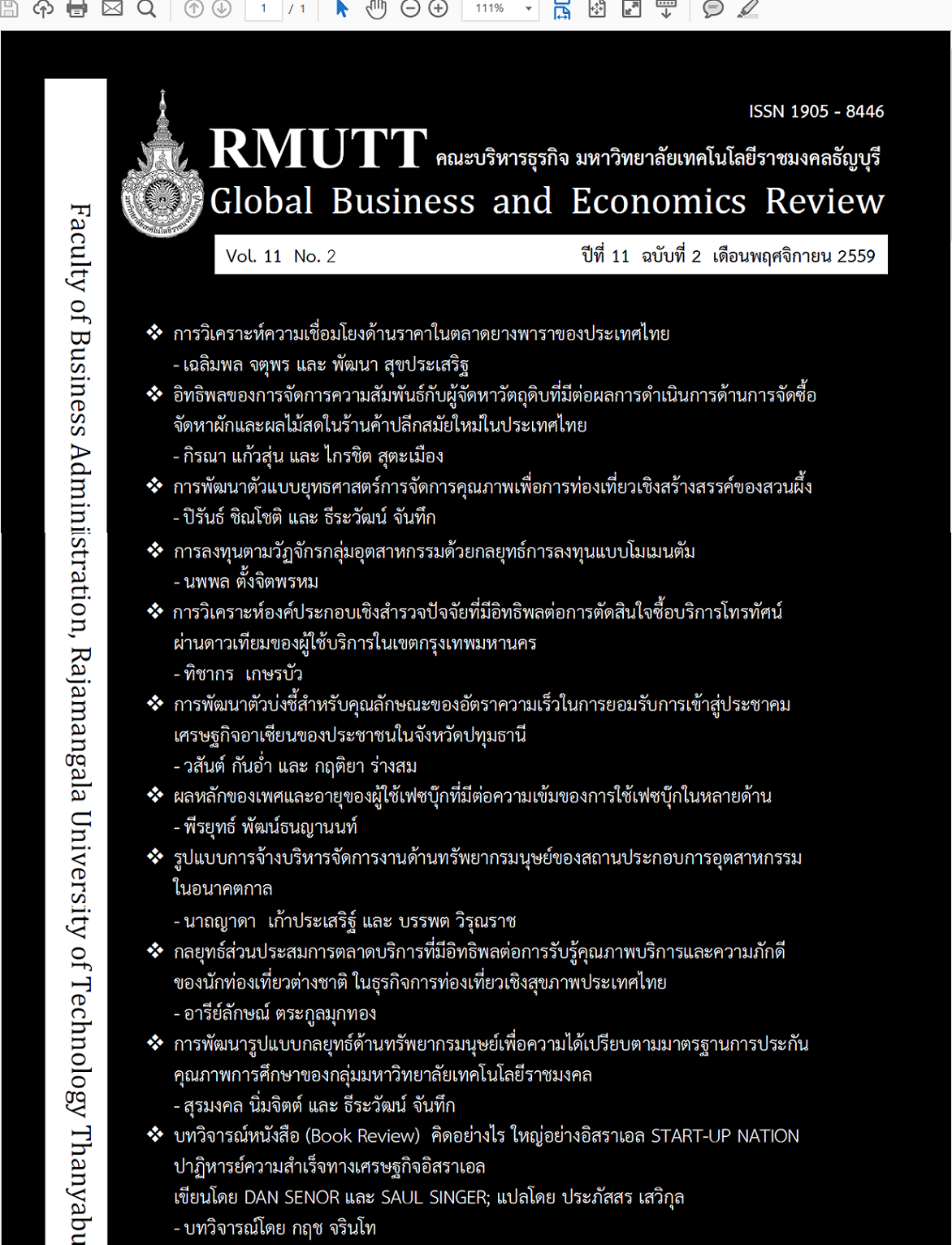DEVELOPMENT OF THE STRATEGIC QUALITY MANAGEMENT FOR CREATIVE TOURISM OF SUAN PHUENG MODEL
Keywords:
Quality Management, Tourism, Creative TourismAbstract
This qualitative research included with 2 steps. First, in-depth interview with 17 stakeholders who related with tourism in Suan Phueng, Ratchaburi. Second, focus group with 12 stakeholders who related with tourism in Suan Phueng, Ratchaburi. The research found that the strategic quality management for creative tourism of Suan Phueng model will be the way to improve the tourism in Suan Phueng with collaboration of all stakeholders to promote tourism activities, products and services also conserving the nature and local culture at the same time. These will increase the number of quality tourist who will satisfy from learning and improve their skills by travelling in creative destination. The improvement of tourism in Suan Phueng will create economic prosperity to all stakeholders’ leads tourism sustainability to Suan Phueng. Then researcher proposed 9 factors of PESS+DIMPE which included, external factors 1) Performance 2) Efficiency 3) Standard 4) Satisfaction; and internal factors, 5) Destination 6) Innovation 7) Man 8) Process 9) Economic
References
การท่องเที่ยวแห่งประเทศไทย. (2554). เศรษฐกิจสร้างสรรค์. สืบค้นจาก http://www.etatjournal.com/mobile/index.php/ menu-read-tat/menu-2011/menu2011-apr-jun/107-22554-creative-economy
คณะกรรมการบริหารงานจังหวัดแบบบูรณาการ จังหวัดราชบุรี. (2556). แผนพัฒนาจังหวัดราชบุรี พ.ศ. ๒๕๕๗ – ๒๕๖๐. สืบค้นจาก http://www.ratchaburi.go.th/plan-2551/
เซนจู ชิซุโอะ. (2542). TQC and TPM. (พิมพ์ครั้งที่ 2). กรุงเทพฯ: สมาคมส่งเสริมเทคโนโลยี (ไทย-ญี่ปุ่น).
ทัศนีย์ นาคเสนีย์. (2553). พฤติกรรมการเลือกซื้อสินค้าของชาวไทย และชาวต่างประเทศ ในแหล่งท่องเที่ยวของจังหวัดราชบุรี (งานวิจัย). ราชบุรี: มหาวิทยาลัยราชภัฏหมู่บ้านจอมบึง.
ทิพวรรณ หล่อสุวรรณรัตน์. (2546). องค์การคุณภาพ: แนวคิดในการพัฒนาคุณภาพแบบยั่งยืน. วารสารพัฒนาบริหารศาสตร์, 43(1), 73-91.
ประชาชาติธุรกิจออนไลน์. (2556, ธันวาคม). เปิดโรดแมปธุรกิจท่องเที่ยว "สวนผึ้ง" นักลงทุนปรับกลยุทธ์เชิง รุกสู้ตลาดฝืดปี 57. ประชาชาติธุรกิจออนไลน์. สืบค้นจาก http://www.prachachat.net/ news_detail.php?newsid=1387360432
ปิรันธ์ ชิณโชติ. (2559). เส้นทางสู่ความสำเร็จ “ฟาร์มแกะในตำนาน ซีนเนอรี่ วินเทจ ฟาร์ม” กรณีศึกษาผู้ประกอบการสวนผึ้ง. Veridian E-Journal, 9(1), 981-993.
ปิรันธ์ ชิณโชติ และ ธีระวัฒน ์จันทึก. (2559). รูปแบบการจัดการการท่องเที่ยวเชิงสร้างสรรค์ของสวนผึ้ง. Veridian E-Journal, 9(1), 250-268.
พรประภา ไชยอนุกูล. (2557). คุณภาพการให้บริการของสถานที่ท่องเที่ยวที่มีผลต่อความพึงพอใจของนักท่องเที่ยวชาวไทยใน อำเภอสวนผึ้ง จังหวัดราชบุรี. (วทิยานิพนธ์ปริญญามหาบัณฑิต, มหาวิทยาลัยเทคโนโลยีราชมงคลธัญบุรี).
พิทักษ์ ศิริวงศ์ และ ปัทมอร เส็งแดง. (2554). การท่องเที่ยวของผู้พิการทางการเคลื่อนไหวในสังคมไทย. Veridian E-Journal, 4(2), 221-228.
ภูริวัจน์ เดชอุ่ม. (2556). การพัฒนาการท่องเที่ยวเชิงสร้างสรรค์: กรอบแนวคิดสู่แนวทางปฏิบัติสำหรับประเทศไทย. วารสารมหาวิทยาลัยศิลปากร ฉบับภาษาไทย, 33(2), 331-366.
มนัสสินี บุญมีศรีสง่า. (2558). การให้ความหมายรูปแบบและกลยุทธ์การตลาดการท่องเที่ยวแบบดาร์กทัวร์ รึซึ่ม พื้นที่จังหวัดกาญจนบุรี.Veridian E-Journal, 8(2), 571-592.
มุทริกา พฤกษาพงษ์. (2554, กรกฎาคม). เที่ยวอย่างเข้าใจไปกับ“การท่องเที่ยวเชิงสร้างสรรค์. ผู้จัดการ ออนไลน์. สืบค้นจาก http://w3.manager.co.th /Travel/ViewNews.aspx?NewsID=9540000080464&TabID=3&
ศันสนีย์ วุฒยาภาธีรกุล. (2552). มาตรฐานการท่องเที่ยว ยกระดับคุณภาพการท่องเที่ยว. For Quality, 15(138), 85-88.
ศูนย์วิจัยด้านตลาดการท่องเที่ยว. (2558, มกราคม – มีนาคม). เข็มทิศท่องเที่ยว. สืบค้นจาก http://marketingdatabase.tat.or.th/ewt_dl_link.php?nid=1775&filename=index
อมรรัตน์ วงศ์เป็ง. (2552). ปัจจัยทางการตลาดที่มีอิทธิพลต่อการตัดสินใจท่องเที่ยวประเทศไทยของนักท่องเที่ยวชาวยุโรป. RMUTT Global Business and Economics Review, 4(2), 39-57.
Al-Ababneh, M. (2013). Service quality and its impact on tourist satisfaction. INTERDISCIPLINARY JOURNAL OF CONTEMPORARY RESEARCH IN BUSINESS, 4(12). 164-177.
Andam, R, Montazeri, A., Feizi, S., & Mehdizadeh, R. (2015). Providing a multidimensional measurement model for assessing quality of sport tourism services: empirical evidence from sport conference as sport event tourism. Iranian Journal of Management Studies, 8(4), 607-629.
Andersson, L. & Thompson, S. (2008). Performative experiments and cultural re-planningrecapturing the spectacle of the city. Nordic Journal of Architectural Research, 20(1). 39-51.
Basiony, A. E., Abd Alla, G., Shaker El Sayed, A. (2014). Evaluating Tourism Service Quality Provided to the European Tourist "Applied on the British tourist. Retrieved from https://mpra.ub.uni-muenchen.de/57164/
Booyens, I., & Rogerson, C. M. (2015, December). Creative tourism in Cape Town: an innovation perspective. Urban Forum, 26(4), 405-424.
Burkart, A. j. & Medlink, S. (1981). Tourism: Past, Present and Future. (2nded.). Oxford: Butterworth-Hienemann.
Crosby, P. B. (1979). Quality is free: the art of making quality certain. USA: American Library.
David, L. (2014). Tourism ecology: towards the responsible, sustainable tourism future. Worldwide Hospitality and Tourism Themes, 3(3), 210-216.
Eber, S. (1993). Beyond the Green Horizon: Principles for Sustainable Tourism. Godalming, Surrey : WWF UK (World Wide Fund for Nature).
Evans, R. J. & Lindsay, M. W. (2010), Managing for Quality and Performance Excellence. USA: South-Western Cengage Learning.
Garvin, D. A. (1988). Managing Quality. New York: Free Press.
Hall, R. (1993). The Soul of the Enterprise. New York: Harper Business.
Ivanov, S. & Ivanova, M. (2013). Mass ecotourism vs. Eco mass tourism. In Proceedings of the Sixth Black Sea Tourism Forum, 2nd- 4th October, 2013 (pp. 78-90) Varna: Bulgaria.
KOREZ-VIDE, R. (2013). Creative Tourism as a Source of Innovativeness and Sustainability in Tourism. Retrieved from http://search.proquest.com/docview/1566187192?pqorigsite=gscholar
Lee, Y J.. (2015). Creative Experience and Revisit Intention of Handmade Oriental Parasol Umbrella in Kaohsiung. World Academy of Science, Engineering and Technology. International Journal of Social, Behavioral, Educational, Economic, Business and Industrial Engineering, 8(9), 2801-2804.
Parasuraman, A., Zeithaml, V. & Berry, L. (1990). Delivering quality service. New York, NY: The Free Press.
Richards, G. (2010). Creative Tourism and Local Development In Wurzburger. In Creative Tourism A Global Conversation how to provide unique creative experiences for travelers worldwide: at present at the 2008 Santa Fe & UNESCO International Conference on Creative Tourism in Santa Fe (pp. 78-90). New Mexico, USA.
Richards, G. & Raymond, C. (2000). Creative tourism. ATLAS News, 23, 16-20.
Richards, G. & Wilson, J. (2006). Developing creativity in tourist experiences: a solution to the serial reproduction of culture?. Tourism Management, 27, 1408-1413.
Soultana (Tania) Kapiki. (2012). Quality management in tourism and hospitality: an exploratory study among tourism stakeholders. International Journal of Economic Practices and Theories, 2(2), 53-61.
UNESCO. (2006). Towards sustainable strategies for creative tourism discussion report of the planning meeting for 2008. In International Conference on Creative Tourism Santa Fe, (2006, October 25-27). New Mexico, USA.
United Nations Environment Programme and World Tourism Orgatiozation. (2005). Making Tourism More Sustainable: A Guide for Policy Makers. Retrieved from http://www.unep.fr/shared/publications/pdf/ DTIx0592xPA-TourismPolicyEN.pdf
Vajčnerová, I., Žiaran, P., Ryglová, K., & Andráško, I. (2014). Quality management of the tourist destination in the context of visitors’ satisfaction. Procedia. Economics and Finance, 12, 718-724.
World Tourism Organization. (2003). Quality standards, Guide for Local Authorities on Developing Sustainable Tourism. Retrieved from http://www.eunwto.org/doi/book/ 10.18111/9789284402809.
Yuan, Y. Y. (2013). Adding environmental sustainability to the management of event tourism. International Journal of Culture, Tourism and Hospitality Research, 7(2), 175-183.
Downloads
Published
How to Cite
Issue
Section
License
The articles published in this journal are the intellectual property of their respective authors.
The views and opinions expressed in each article are solely those of the individual authors and do not reflect the positions of Rajamangala University of Technology Thanyaburi or any of its faculty members. All components and content of each article are the sole responsibility of the respective authors. In the event of any errors, the authors shall bear full responsibility for their own work.








